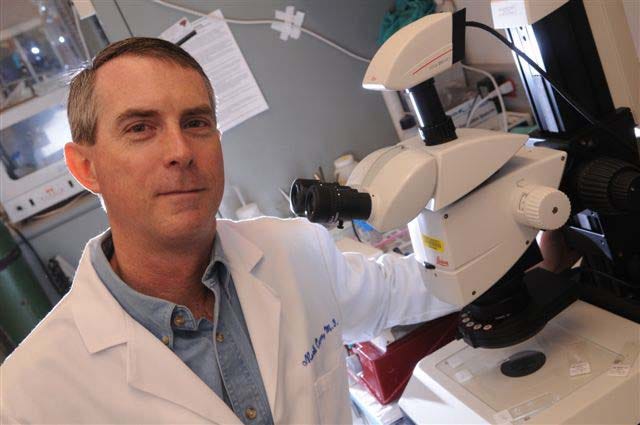Father Hopes NIH Distinction for Indy-Developed Drug Could Save Daughter’s Life
 Chondrial Therapeutics says Dr. Mark Payne's discoveries could turn a devastating disease into "a very manageable
Chondrial Therapeutics says Dr. Mark Payne's discoveries could turn a devastating disease into "a very manageable
Subscriber Benefit
As a subscriber you can listen to articles at work, in the car, or while you work out. Subscribe NowFriedreich’s ataxia (FA) is a rare—and especially cruel—disease. Tom Hamilton knows the heartache well; his 11 year-old daughter Annie deteriorates physically with each passing day. He says saving her life is “a race against the clock,” and he’s hopeful Indianapolis-based Chondrial Therapeutics could give his family more years with Annie. The National Institutes of Health (NIH) just accepted the startup’s drug candidate into a prestigious program that will accelerate its development—and perhaps help put time on Annie’s side.
NIH’s Therapeutics for Rare and Neglected Diseases (TRND) program has selected Chondrial Therapeutics’ drug, called TAT-Frataxin, for its highly-competitive program that focuses on speeding development and footing the bill to get the company to Phase 1 clinical trials. It’s the second critical development for TAT-Frataxin; the first came from a father.
Hamilton, who lives in New York, worked on Wall Street for 25 years, but left the industry a few years ago to spend more time with his family. Three months later, doctors diagnosed Annie with FA.
“My wife and I often say we’ve been given a very large dose of perspective,” says Hamilton. “All the things you thought were important—you realize really aren’t.”
“Horrible” is the word Hamilton uses to describe FA, which has no treatment. Parents think they have a healthy child until about the age of 10, when typical adolescent clumsiness becomes so pronounced that they begin to suspect something else may be at play. Annie’s prognosis is the same as the 50,000 other people in the U.S. with the disorder; she’ll likely be in a wheelchair by her teenage years and die in her mid-20s or mid-30s due to cardiovascular complications.
“You don’t sleep for about six months [after the diagnosis], and then you realize that doesn’t help anyone either,” says Hamilton. “We try to put our head down and put all of our resources, time and energy toward trying to get a cure for these kids.”
After Annie’s diagnosis, Hamilton contacted the FA Research Alliance, a global organization focused on finding a treatment or cure for the disorder.
“I said, ‘What do you guys need? Tell me therapies that need help that don’t have sponsorship,” says Hamilton. “They said there’s a doctor in Indiana, Mark Payne, and he has a protein therapeutic drug that we think has some legs.”
Hamilton started throwing millions of his own money at the disease; he gave more than $3 million to establish a FA research center at The Children’s Hospital of Philadelphia, and he invested $1.1 million in Chondrial Therapeutics to secure the intellectual property for TAT-Frataxin.
FA is a genetic disorder that limits the production of frataxin, an important protein that functions in the mitochondria, known as the energy-producing factories of the cell. Patients lose sensory nerves in their extremities and, ultimately, develop serious heart conditions.
Payne, who is an Indiana University School of Medicine professor of pediatrics, developed the drug to deliver frataxin to the mitochondria of the cells, allowing the cells to produce energy normally and not die.
“Think of it like giving insulin to diabetics. If you can provide frataxin, you turn a pretty devastating disease into a very manageable, high quality-of-life, chronic disease,” says Chondrial Therapeutics Chief Executive Officer Steven Plump. “While patients need to continue to receive that frataxin over their lifetime, it restores the productivity of those cells and—at least in animal studies to date—extends their life.”
Plump says being selected for the TRND program greatly “de-risks” development expenses and unleashes the power of TRND’s scientists to move TAT-Frataxin to human trials. For Hamilton, the advancements can’t come fast enough; while a treatment wouldn’t reverse Annie’s condition, it will stop the progression, which could mean saving her life.
“It’s heart-wrenching seeing your kid walk down the stairs, and every day, it gets harder. She’s lost some pretty serious neuronal capability, so we have to do it for others; if we can save other kids, that’s worth it as well,” says Hamilton. “I think in five years, there will be a therapy. I’m hoping it’s much sooner. I need it sooner.”
With several potential pathways for treatment, Hamilton believes FA is “a fixable problem.”
Plump says Chondrial Therapeutics has discovered the molecule and will now rely on TRND’s expertise in drug development.
Plump likens the functionality of Chondrial Therapeutics’ drug to Eli Lilly developing insulin.
